How Mobile Telephony Turned into a Health Scare, Some Facts and Theories about Flu, Changes in International Commerce – IELTS Reading Answers
22 min read
Updated On
-
Copy link
Table of Contents

Limited-Time Offer : Access a FREE 10-Day IELTS Study Plan!
The Reading Module of the IELTS can be the top-scoring category, with diligent practice. To achieve the best results in this section, you must understand how to approach and answer the different Question types in the Reading Module. By solving and reviewing Sample Reading Questions from past IELTS papers, you can ensure that your Reading skills are up to the mark.
In the Academic Reading practice test, “How Mobile Telephony Turned into a Health Scare, Some Facts and Theories about Flu, and Changes in International Commerce” there are 40 questions of various question types. We at IELTSMaterial.com would urge every IELTS aspirant to time this test as in the real exam and find the answers without looking at the key. If you have scored 40/40, then we wish you all the best. If you haven’t, then we would earnestly advise you to take one of our IELTS reading practice tests.
Here are question types in this reading test
Reading Passage 1 (How Mobile Telephony Turned into a Health Scare)
- Short answer questions
- Diagram completion
- Multiple Choice Questions
Reading Passage 2 ( Some Facts and Theories about Flu)
- True or False / Not Given
- Matching information
- Short answer questions
Reading Passage 3 ( Changes in International Commerce)
- Matching information
- Flowchart completion
- Multiple Choice Questions
Reading Passage 1
How Mobile Telephony Turned into a Health Scare
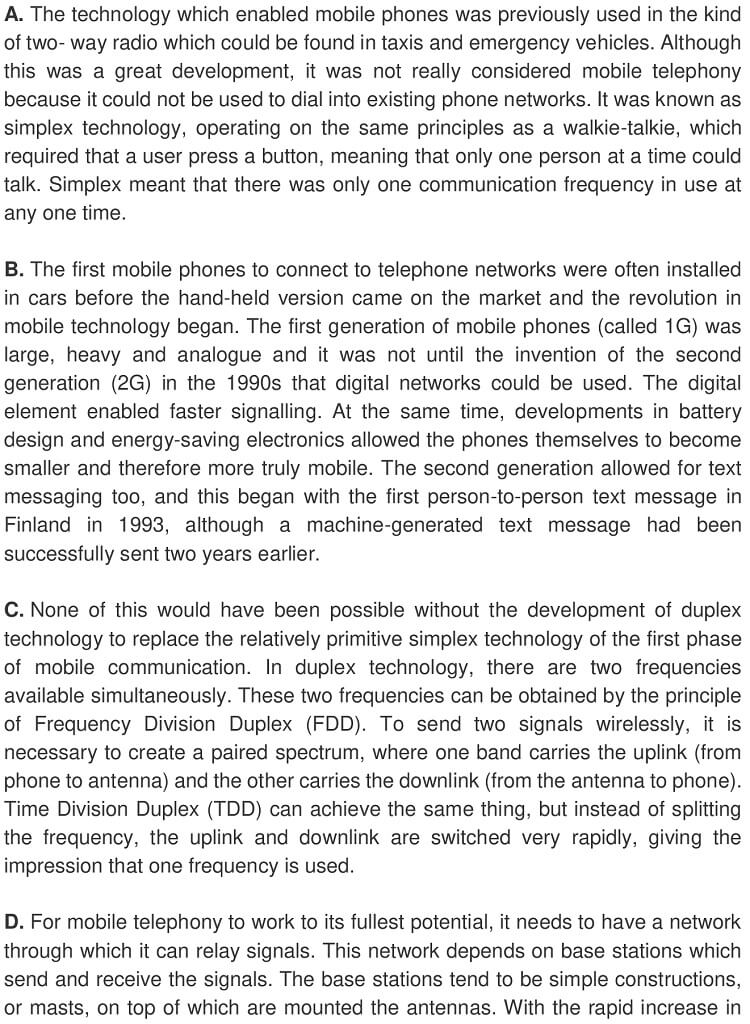
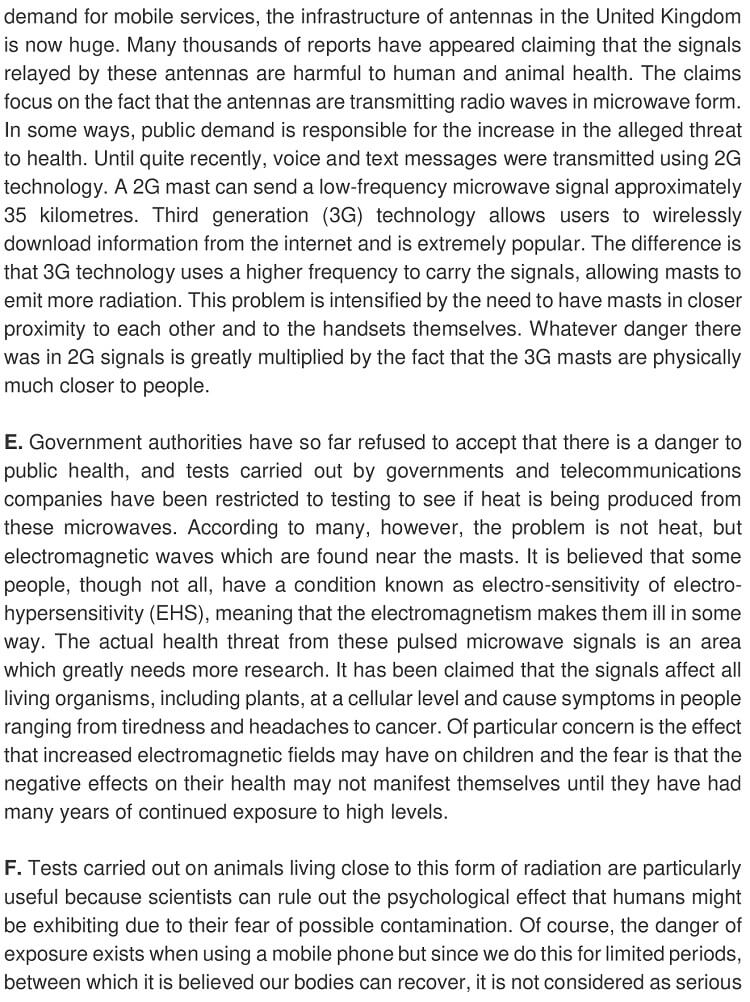

[do_widget id=custom_html-23]
Questions 1-6
Answer the questions below.
Write NO MORE THAN THREE WORDS for each answer.
1 What were early two-way radios unable to use?
2 What did you have to do in order to talk on the radio using simplex technic?
3 Where were early mobile phones generally used?
4 What development introduced digital technology into mobile telephony?
5 Apart from the area of electronics, in which area did developments help make phones more mobile?
6 What type of text message was the first one ever sent?
Questions 7-10
Complete the diagram.
Choose NO MORE THAN TWO WORDS from the passage for each answer.
Frequency Division Duplex (FĐD) two signals sent 7________________
Two bands together, known as a 8________________
9 ________________
10________________
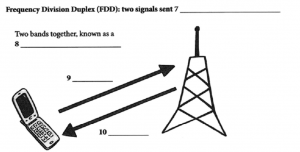
Questions 11-13
11 3G technology is believed to be more of a threat to health because
A the signals are transmitted over much greater distances than before.
B the masts are closer together and emit higher frequencies.
C the signals are carrying both voice and text messages.
D the modern handsets needed to emit more radiation.
12 Why might the testing of animals give us more reliable results?
A because most of them live closer to the masts
B because they are continually exposed to higher levels of radiation
C because they are not affected at a cellular level
D because they are not afraid of the effects of radiation
13 What is believed to limit the danger from mobile phones?
A not using them continuously
B turning them off when not in use
C mounting a mast on the building where you live or work
D keeping healthy and getting enough sleep
Also check:
- IELTS Reading
- IELTS Reading tips
- True False Not Given IELTS Reading
- IELTS Reading recent actual test
- IELTS Academic Reading test papers with answers pdf
Reading Passage 2
Some Facts and Theories about Flu
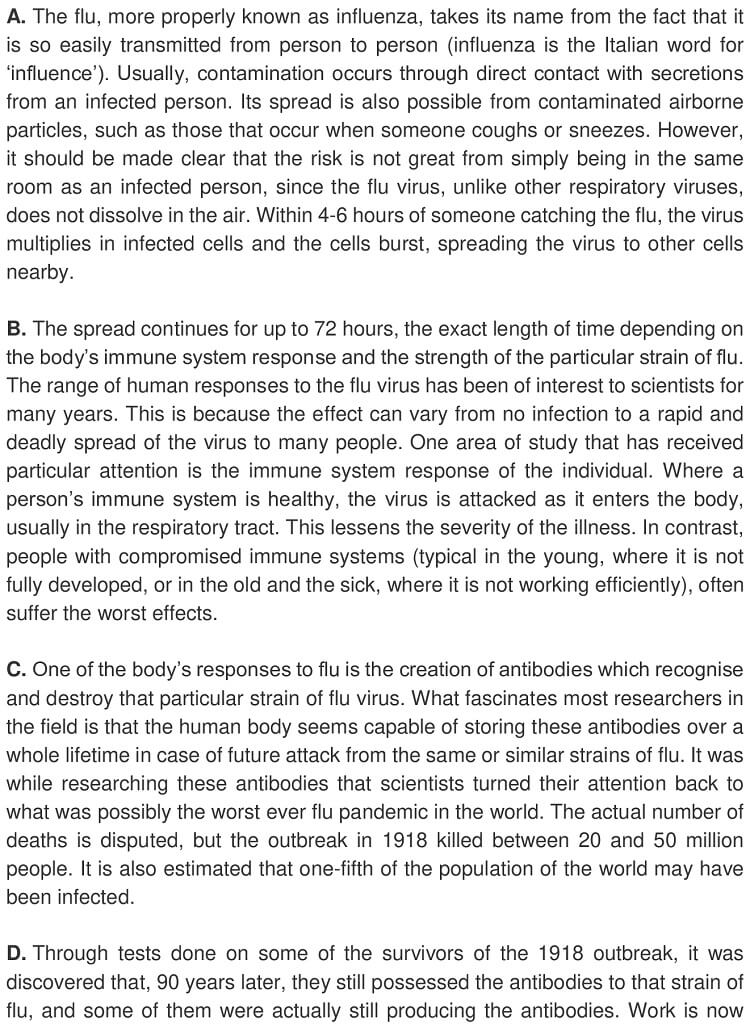
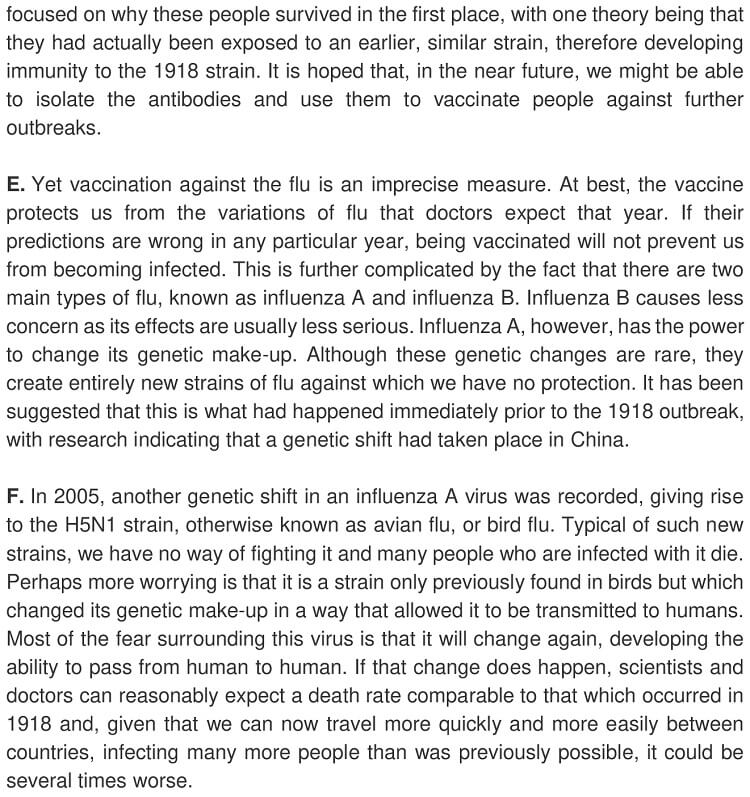
Questions 14-20
Do the following statements agree with the information given in Reading Passage 2?
TRUE, if the statement agrees with the information
FALSE, if the statement contradicts the information
NOT GIVEN, if there is no information on this
14 The only way to catch flu is if someone coughs or sneezes near you.
15 You become aware of the symptoms of flu within 4-6 hours of infection.
16 The effect of flu infection can depend on how strong the strain is.
17 Those who are more likely to suffer badly with the flu include very young or very old people.
18 Although antibodies last a lifetime, scientists have found they get weaker with
age.
19 Vaccination is largely ineffective against flu.
20 Another change in the genetic make-up of the H5N1 strain could kill more people than the 1918 epidemic.
Questions 21-24
Write the correct letter, A, B or C.Write the correct letter, A, B, or C.
Classify the following statements as characterizing
A something is known by scientists to be true
B something believed by scientists to be true
C something is known by scientists to be false.
21 Sharing a room with a flu sufferer presents a very high risk to your health.
22 One-fifth of the people in the world caught the flu in 1918.
23 Influenza-A viruses do not change their genetic make-up frequently.
24 The H5N1 strain evolved in or before 2005.
Questions 25 and 26
Write the correct letter, A, B or C.Answer the questions below.
Write NO MORE THAN THREE WORDS for each answer.
25 In which part of the body do antibodies normally attack the flu virus?
26 What kind of transmission of the H5N1 strain are people afraid might become
reality?
Reading Passage 3
Changes in International Commerce
How ethics and fair trade can make a difference

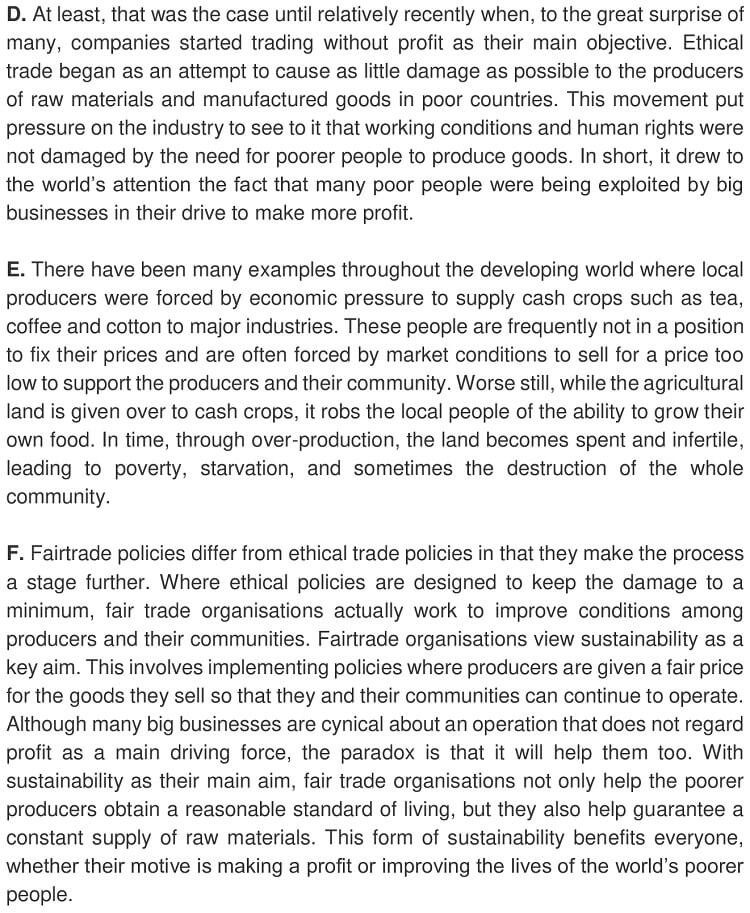
Questions 27-31
Write the correct letter, A, B or C.Write the correct letter, A, B or C.
Classify the following as being a result of
A fair trade policies
B ethical trade policies
C a country being poor.
27 Manufactured goods are obtainable at a lower price than elsewhere.
28 Harm to producers of raw materials is minimised.
29 Human rights are respected.
30 The land is not used to produce food for the local population.
31 The local community has more chance of survival.
Questions 32-36
Complete the flow chart below.
Use NO MORE THAN THREE WORDS from the passage for each answer.
Companies carry out 32___________________to decide the price that their goods are sold at in each country. The prices of the same goods can vary in different countries because of 33___________________or taxes. The 34_____________________is finalised, depending on how much customers in a particular market can afford. To ensure a profit, manufacturers aim to sell the 35_______________________ of a particular item. Manufacturers can have a higher profit margin on luxury or specialist goods which often have a 36_________________________
Questions 37-40
Choose the correct letter, A, B, C or D, and write them next to 37-40 on your answer sheet.
37 According to the writer, what might early traders have disagreed about?
A the comparative values of the goods
B which currency to use for their deal
C which items they wanted as an exchange
D the quality of the goods being traded
38 What is the main consequence of a product being in demand?
A higher prices
B smaller profit margins
C fewer items being produced
D less market competition
39 How might an agricultural community be destroyed?
A because companies in richer countries steal from them
B because they ask an unrealistically high price for their produce
C because they over-use the land in order to grow cash crops
D because the crops take much too long to grow
40 The word paradox in the final paragraph refers to the fact that
A poorer people will become richer than the people who run big businesses.
B by being cynical, the big businesses have helped produce a result they do not want.
C the suppliers of raw materials will sell them to big businesses for a huge profit.
D big businesses will gain from these policies although they don’t support them.
Answers
Unlock Answer
Signup/Login and get access to the answers
How Mobile Telephony Turned into a Health Scare Reading Answers (Passage 1)
1 Answer: (existing) phone networks
Question type: Short Answer Question
Answer location: Paragraph A
Answer explanation: The initial lines of paragraph A states that the technology which enabled mobile phones was previously used in the kind of two- way radio which could be found in taxis and emergency vehicles. Although it was a great development, it was not really considered mobile telephony because it could not be used to dial into existing phone networks. These lines reveal that the technology enabling phones was earlier used in the kind of two- way radio, which was a great development. However, it was not considered med mobile telephony as it couldn’t be used to dial existing phone networks. Thus, the existing phone networks were early two-way radios unable to be used.
2 Answer: press a button
Question type: Short Answer Question
Answer location: Paragraph A, line 3
Answer explanation: We can deduce from the 3rd line of paragraph A that in the simplex technology, only one person at a time could talk using the same principles as a walkie-talkie, which required that a user press a button. Thus, in order to talk on the radio using simplex technique, a user has to press a button.
3 Answer: (in) cars
Question type: Short Answer Question
Answer location: Paragraph B
Answer explanation: We can deduce from the initial lines of paragraph B that the first mobile phones to connect to telephone networks were installed in cars before the hand-held version came into picture, resulting in the revolution of mobile technology. Hence, it is evident that early mobile phones were generally used in cars.
4 Answer: 2G/ the second generation
Question type: Short Answer Question
Answer location: Paragraph B, line 3
Answer explanation: Paragraph B discusses the revolution of mobile technology. So, we can find reference in the 3rd line, which states that it was not until the invention of the second generation (2G) in the 1990s that digital networks could be used. The digital element enabled faster signalling. These lines reveal that it was the second generation (2G) which introduced digital technology into mobile telephony. Thus, the answer is 2G/ the second generation.
5 Answer: battery design
Question type: Short Answer Question
Answer location: Paragraph B, line 5
Answer explanation: Paragraph B states the revolution of mobile technology. The 5th line states that when the 2G was introduced, developments in battery design and energy-saving electronics allowed the phones themselves to become smaller and therefore more truly mobile. These lines indicate that the developments in the area of electronics and battery design helped make phones more mobile. Thus, the answer is battery design.
6 Answer: machine-generated
Question type: Short Answer Question
Answer location: Paragraph B, line 6
Answer explanation: The 6th line of paragraph B illustrates that the second generation allowed for text messaging, which began with the first person-to-person text message in Finland in 1993, although a machine-generated text message had been successfully sent two years earlier. These lines elucidate that although the 2G allowed text messaging, the first ever sent message was a machine-generated text message. So, the answer is machine-generated.
7 Answer: wirelessly
Question type: Diagram Completion
Answer location: Paragraph C, line 3
Answer explanation: We can understand from the 3rd line of paragraph C that two frequencies can be obtained by the principle of Frequency Division Duplex (FDD) and in order to send two signals wirelessly, it is necessary to create a paired spectrum, where one band carries the uplink (from phone to antenna) and the other carries the downlink (from the antenna to phone). These lines suggest that to send two signals wirelessly, it is important to create a paired spectrum, where one band carries the uplink and the other carries the downlink. So, the answer is wirelessly.
8 Answer: paired spectrum
Question type: Diagram Completion
Answer location: Paragraph C, line 4
Answer explanation: The 4th line of paragraph B states that to send two signals wirelessly, it is necessary to create a paired spectrum, where one band carries the uplink (from phone to antenna) and the other carries the downlink (from the antenna to phone). We understand that it is essential to create a paired spectrum (two bands) to send two signals wirelessly. Thus, the two bands together are known as paired spectrum.
9 Answer: uplink
Question type: Diagram Completion
Answer location: Paragraph C, line 5
Answer explanation: Paragraph C states the process to send two signals wirelessly, and that it is necessary to create a paired spectrum, where one band carries the uplink (from phone to antenna) and the other carries the downlink (from the antenna to phone). We understand that two bands together are created where one band from phone to antenna carries uplink and the other carries downlink, so, according to the diagram, the band from phone to antenna carries uplink. Thus, the answer is uplink.
10 Answer: downlink
Question type: Diagram Completion
Answer location: Paragraph C, line 5
Answer explanation: Paragraph C illustrates the process of sending two wireless signals and that it is necessary to create a paired spectrum, where one band carries the uplink (from phone to antenna) and the other carries the downlink (from the antenna to phone). These lines indicate that two bands are required to send two signals wirelessly, where one band from phone to antenna is carrying uplink, the other band from antenna to phone is known as downlink. So, according to the diagram, the band from antenna to phone carries a downlink. Thus, the answer is downlink.
11 Answer: B
Question type: Multiple Choice Question
Answer location: Paragraph D, line 11
Answer explanation: The 11th line of paragraph D states that the 3G technology uses a higher frequency to carry the signals, allowing masts to emit more radiation. This problem is intensified by the need to have masts in closer proximity to each other. These lines reveal that 3G technology is believed to be more of a threat to health because the masts are in closer proximity and emitting higher frequencies. So, the answer is B.
12 Answer: D
Question type: Multiple Choice Question
Answer location: Paragraph F
Answer explanation: The initial lines of Paragraph F states that tests carried out on animals living close to this form of radiation are particularly useful because scientists can rule out the psychological effect that humans might be exhibiting due to their fear of possible contamination. These lines suggest that testing of animals in the radiation might provide reliable results because scientists can rule out psychological effects that humans are afraid of due to contamination. Also, animals are not afraid of the radiation effects. So, the answer is D.
13 Answer: A
Question type: Multiple Choice Question
Answer location: Paragraph F, line 3
Answer explanation: The 3rd line of paragraph F elucidates that the danger of exposure exists when using a mobile phone but since we do this for limited periods, between which it is believed our bodies can recover, it is not considered as serious as the effect of living or working near a mast (sometimes mounted on the very building we occupy) which is transmitting electromagnetic waves 24 hours a day. These lines suggest that although there’s a danger, using mobile phones for limited periods of time might help the body to recover, which is not as serious as a person living near a mast which transmits electromagnetic waves 24hrs a day. Thus, the answer is A.
Some Facts and Theories about Flu Reading Answers (Passage 2)
14 Answer: False
Question type: True/False/Not Given
Answer location: Paragraph A, line 2
Answer explanation: The 2nd line of paragraph A states that usually, contamination occurs through direct contact with secretions from an infected person. Its spread is also possible from contaminated airborne particles such as those occur when someone coughs or sneezes. These lines suggest that contamination occurs via direct contact with an infected person’s secretion, but the spread is also possible from contaminated airborne particles that occur when someone sneezes or coughs. So, the statement contradicts the information. Thus, the answer is False.
15 Answer: Not Given
Question type: True/False/Not Given
Answer location: Paragraph A, line 6
Answer explanation: The 6th line of paragraph A states that within 4 – 6 hours of someone catching the flu, the virus multiplies in infected cells, which burts, and spreads the virus to other cells nearby. These lines indicate that the virus multiplies and spreads within 4 – 6 hours of someone catching the flu. However, it’s not mentioned that the infected person will be aware of the symptoms of flu within 4 – 6 hours. Thus, the answer is Not Given.
16 Answer: True
Question type: True/False/Not Given
Answer location: Paragraph B
Answer explanation: The initial lines of paragraph B states that the spread continues for up to 72 hours, the exact length of time depending on the body’s immune system response and the strength of the particular strain of flu. The range of human responses to the flu virus has been of interest to scientists for many years. This is because the effect can vary from no infection to a rapid and deadly spread of the virus to many people. These lines indicate that the effect of a flu infection fan depends on how strong the strain is. Thus, the answer is True.
17 Answer: True
Question type: True/False/Not Given
Answer location: Paragraph B, line 7
Answer explanation: The 7th line of paragraph B illustrates that people with compromised immune systems (typical in the young, where it is not fully developed, or in the old and the sick, where it is not working efficiently), often suffer the worst effects. We can deduce from these lines that people have compromised immune systems such as the young ones (where the immune system is not entirely developed), old people and infected people (where the immune system is not working properly) are the ones who get affected with the worst effects. Thus, the answer is True.
18 Answer: Not Given
Question type: True/False/Not Given
Answer location: Paragraph D
Answer explanation: Paragraph D illustrates that some survivors from 1918 still had antibodies and some were still producing them. However, there’s no reference for information on whether the antibodies get weaker with age. Thus, the answer is Not Given.
19 Answer: False
Question type: True/False/Not Given
Answer locations: Paragraph E
Answer explanations: The initial lines of Paragraph E, states that vaccination against the flu is an imprecise measure. At best, the vaccine protects us from the variations of flu that doctors expect that year. These lines suggest that vaccination is essential for any type of flu or disease to slow down their effects and spread in the body. Thus, the statement contradicts the information, so, the answer is False.
20 Answer: True
Question type: True/False/Not Given
Answer locations: Paragraph F
Answer explanations: Paragraph C discusses the recording of another genetic shift in an influenza A virus in 2005, which gave a rise to the H5N1 Strain. It is stated that with the introduction of such new strains, there was no way to fight against it and that the infected people might die. The 6th line of the paragraph elucidates that if there’s another change in the genetic makeup of the strain, a death rate comparable to that which occurred in 1918 could be expected. Thus, these lines agree with the statement, so, the answer is True.
21 Answer: C
Question type: Matching Information
Answer locations: Paragraph A, line 4
Answer explanations: We can deduce from the 4th line of paragraph A that it should be made clear that the risk is not great from simply being in the same room as an infected person, since the flu virus, unlike other respiratory viruses, does not dissolve in the air. This statement contradicts the information because sharing a room with an infected person presents a high risk to health because doctors proved that flu viruses do not dissolve in the air and that it affects the cells inside the human body. So, the answer is C – something is known by scientists to be false.
22 Answer: B
Question type: Matching Information
Answer locations: Paragraph C, line 5
Answer explanations: The 5th line of paragraph C illustrates that the actual number of deaths is disputed, but the outbreak in 1918 killed between 20 and 50 million people, which can be estimated that one-fifth of the population of the world may have been infected. These lines suggest that the 1918 outbreak killed almost 20-50 million people, which is approximately one-fifth of the people in the world, who were affected by the flu. Thus, the answer is B – something believed by scientists to be true.
23 Answer: C
Question type: Matching Information
Answer locations: Paragraph E, line 5
Answer explanations: We can understand from the 5th line of paragraph E that Influenza A, has the power to change its genetic make-up. Although these genetic changes are rare, they create entirely new strains of flu against which we have no protection. These lines indicate that it is very rare in cases where viruses don’t change their characteristics because most of them change their variants after one time. As a result, doctors and scientists find it challenging to rectify it. Thus, the answer is C – something known by scientists to be false.
24 Answer: A
Question type: Matching Information Answer locations: Paragraph F
Answer explanations: The introductory line of paragraph A states that in the year 2005, there was another genetic shift in an Influenza A virus, which gave rise to the H5N1 strain, otherwise known as avian flu, or bird flu. We can deduce from these lines that in 2005, a different variant of Influenza A virus known as H5N1 came into existence. Thus, the answer is A – Something known by scientists to be True.
25 Answer: respiratory tract
Question type: Short Answer Question
Answer locations: Paragraph B, line 5
Answer explanations: The 5th line of paragraph B illustrates that when a person’s immune system is healthy, the virus is attacked as it enters the body, usually in the respiratory tract. These lines indicate that the antibodies attack the flu virus via the respiratory tract. So, the answer is the respiratory tract.
26 Answer: Human to Human
Question type: Short Answer Question
Answer locations: Paragraph F, line 4
Answer explanations: We can deduce from the 4th line in Paragraph G that most of the fear surrounding this virus is that it will change again, developing the ability to pass from human to human. These lines reveal that human-to-human transmission of the strain can be very risky. For instance, if a normal person comes in contact with an infected person, then there might be a chance for the normal person to get infected. Thus, people fear that human-to-human transmission of the virus might become a reality. So, the answer is Human to Human.
Changes in International Commerce Reading Answers (Passage 3)
27 Answer: C
Question type: Matching Information
Answer locations: Paragraph B, line 5
Answer explanations: The 5th line of paragraph B illustrates that people in poor countries simply cannot afford to pay the same amount of money as those in rich countries. These are the things a seller has to bear in mind when preparing a price list for goods in each country. These lines suggest that poor countries are incapable of bargaining a better deal, who endup underselling their manufactured goods at lower prices. So, the answer is C.
28 Answer: B
Question type: Matching Information
Answer locations: Paragraph D, line 2
Answer explanations: We can deduce from the 2nd line of paragraph D that the ethical trade began as an attempt to cause as little damage as possible to the producers of raw materials and manufactured goods in poor countries. These lines indicate that the traders adopted ethical trade practices to avoid little damages to protect the raw materials and manufactured goods of poor countries. Thus, the answer is B.
29 Answer: B
Question type: Matching Information
Answer locations: Paragraph D, line 3
Answer explanations: Paragraph D states the ethical trade practices adopted by the traders to protect raw materials and goods of poor countries. The 3rd line states that this movement put pressure on the industry to see to it that working conditions and human rights were not damaged by the need for poorer people to produce goods. We understand that the implementation of ethical trade practices puts pressure on the industry to check if the human rights and working conditions are not damaged by the requirement for poorer people to produce goods. Thus, the answer is B.
30 Answer: C
Question type: Matching Information
Answer locations: Paragraph E, line 4
Answer explanations: The 4th line of paragraph E illustrates that while the agricultural land is given over to cash crops, it robs the local people of the ability to grow their own food. These lines reveal that the agricultural land is plummeted for cash crops in the pursuit of profit, which is then left spent and overexploitation, resulting in stopping the local people from growing their own food. Thus, the answer is C
31 Answer: A
Question type: Matching Information
Answer locations: Paragraph F, line 3
Answer explanations: The 3rd line of paragraph F states that fairtrade organizations view sustainability as a key aim. This involves implementing policies where producers are given a fair price for the goods they sell so that they and their communities can continue to operate. We understand from these lines that fairtrade organizations consider substantiality as a primary aim, which involves adopting policies where producers are offered a fair price for the goods they sell, which allows them and their community to continue to grow. Thus, the answer is A.
32 Answer: (market) research
Question type: Flowchart Completion
Answer locations: Paragraph B
Answer explanations: We understand from the initial line of paragraph B that when we look at the deal from the point of view of the seller, market research must determine the price at which the goods will be sold. Thus, it is evident that companies carry out market research to evaluate the price at which the goods will be sold. Thus, the answer is Market research.
33 Answer: (local) government controls
Question type: Flowchart Completion
Answer locations: Paragraph B, line 3
Answer explanations: The 3rd line of paragraph B illustrates that the prices of same goods may vary greatly from country to country and people are often surprised to see exactly the same item for sale at two or three times the price it sells for in another country. Taxation and local government controls are sometimes behind this. These lines suggest that the prices of the same goods might vary in different countries because of taxation which is under the control of the local government. Thus, the answer is local government controls.
34 Answer: price list
Question type: Flowchart Completion
Answer locations: Paragraph B, line 6
Answer explanations: Paragraph B states that fixing a fair price remains at the centre of international commerce. The 6th line of paragraph B reveals that there are certain things a seller has to bear in mind when preparing a price list for goods in each country. These lines indicate that there are many factors that influence the price of a commodity and the price must be fixed by considering all those factors. Thus, the answer is Pricelist.
35 Answer: maximum number
Question type: Flowchart Completion
Answer locations: Paragraph C
Answer explanations: Paragraph C discusses the fact that the purpose of setting a suitable price is to sell the maximum number of units, which guarantee the biggest profit. These lines suggest that manufacturers aim to sell a maximum number of units of a particular item to ensure maximum profit. So, the answer is the maximum number.
36 Answer: limited market
Question type: Flowchart Completion
Answer locations: Paragraph C, line 2
Answer explanations: We understand from the 2nd line of paragraph C that the purpose of setting a suitable price for a product is to sell it in maximum numbers, which ensures a guaranteed profit. However, there’s an exception in the selling of luxury or specialist goods. These are often goods for which there is a limited market. Here, slightly different rules apply because the profit margin (the amount of money a producer makes on each item) is much higher. These lines indicate that manufacturers can have higher profit margins on luxury or specialist goods which often have a limited market. So, the answer is limited market.
37 Answer: A
Question type: Multiple Choice Question
Answer locations: Paragraph A, line 4
Answer explanations: The 4th line of paragraph A states all that needed to be negotiated was a fair price for the items. These lines elucidate that fair prices for the items were required to be negotiated. So, it is evident that early traders would have disagreed about the comparative values of the goods. Thus, the answer is A.
38 Answer: B
Question type: Multiple Choice Question
Answer locations: Paragraph C, line 4
Answer explanations: The 4th line of paragraph C illustrates an example, where it is mentioned that nearly everyone wants to own a television or a mobile phone, and there is a lot of competition in the area of production, forcing the prices to be competitive too. The producers have to sell a large number of items to make a profit because their profit margin is small. These lines clearly indicate that the higher the demand, the more the competition, which forces the manufacturers to lower the price of the goods. So, the answer is B.
39 Answer: C
Question type: Multiple Choice Question
Answer locations: Paragraph E, line 4
Answer explanations: The 4th line of paragraph E, states that when the agricultural land is given over to cash crops, it robs the local people of the ability to grow their own food. In time, through over-production, the land becomes spent and infertile, leading to poverty, starvation, and sometimes the destruction of the whole community. We can deduce that the agricultural land is plummeting for cash crops, resulting in them becoming infertile and spent, which stops the local people from growing their own food, leading to poverty, starvation, and the catastrophe of the entire community. So, the answer is C.
40 Answer: D
Question type: Multiple Choice Question
Answer locations: Paragraph F, line 6
Answer explanations: The 6th line of paragraph F states that although many big businesses are cynical about an operation that does not regard profit as a main driving force, the paradox is that it will help them too. These lines indicate that despite several big businesses being cynical about an operation that does not regard profit as the primary driving force, the paradox is that it will assist them. So, the answer is D.
Practice IELTS Reading based on question types

Start Preparing for IELTS: Get Your 10-Day Study Plan Today!
Explore other Reading Practice Tests

Kasturika Samanta

Kasturika Samanta

Nehasri Ravishenbagam
Recent Articles

Nehasri Ravishenbagam

Haniya Yashfeen

Haniya Yashfeen

Haniya Yashfeen
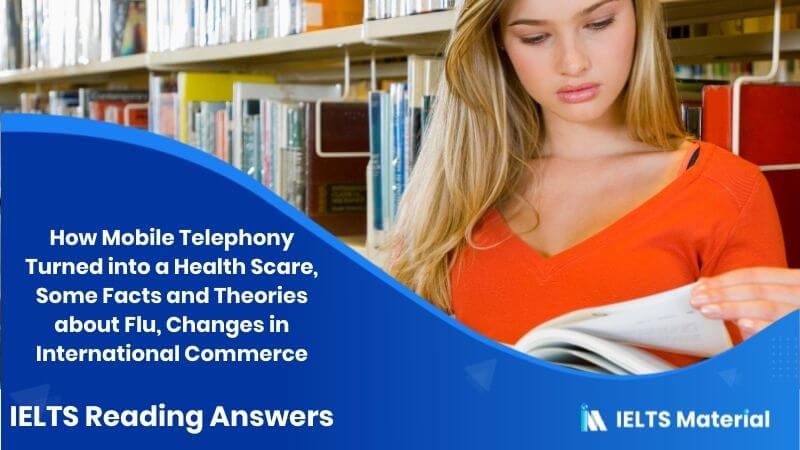



Post your Comments
2 Comments